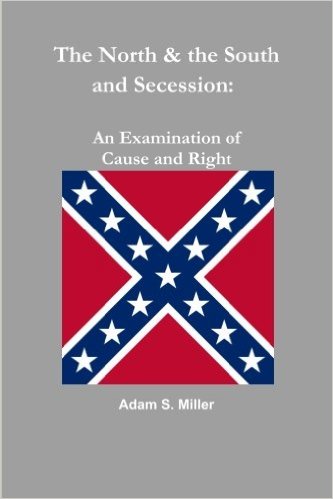Book reviews
 |
 |
 |
 |
 |
 |
 |
The Invasion of the North against the South – Myths & Reality
Book review of The North & The South and Secession: An Examination of Cause and Right, Book I, by Adam S. Miller, Monrovia, MD: Tower of David/Marian Pub., Inc. 2006, 114 pp.
My last article analyzed some of the cultural, economic and political factors that led up to the secession crisis of 1860-1861. The North, filling its coffers with wealth extracted through tariffs imposed on the agrarian South, finally solidified its power with the election of a pro-Northern president, Abraham Lincoln. As a consequence, one Southern State after another began to quit membership in the Union and exercise their right to secede.
Secession
The Republican Party was originally a sectional party predicated on furthering Northern interests, and it was the election of Republican Abraham Lincoln in 1860 that precipitated the secession of several Southern States. Before this time different States, some of them Northern, had threatened to secede over various issues, and there was no doubt as to the legality of such an action. Just that year (1860-1861) Congress had even tried and failed to pass a law that would have officially outlawed state secession.
Many at the time knew that the federal government simply did not have the legal capacity to prevent States from seceding. The Constitution granted no such federal authority. Despite this legal framework, despite the Constitution, and despite the wishes and intentions of the founding fathers (expressed through letters, the Federalist Papers, and the Second amendment and the Bill of Rights) Lincoln retaliated with war.
He called for 75,000 volunteers to put down what he termed the “rebellion” of Southern States. Civil liberties were suspended, and thousands of people who opposed Lincoln’s actions, even loyal Northerners, were imprisoned without trial or due process of law
.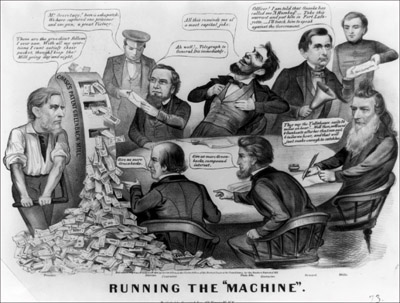 Since no war can be fought without some semblance of a just cause, several myths were invented and propagated to justify Lincoln’s course of action. As he led the Northern armies in an aggressive and unjust war to despoil the South and destroy opposition to the illegal usurpation of power by the federal government, he did so under a false banner of justice, liberty and freedom.
Since no war can be fought without some semblance of a just cause, several myths were invented and propagated to justify Lincoln’s course of action. As he led the Northern armies in an aggressive and unjust war to despoil the South and destroy opposition to the illegal usurpation of power by the federal government, he did so under a false banner of justice, liberty and freedom.
In order to justify these illegal actions and the federal government's use of force in coercing the Southern States, several myths, misrepresentations and outright lies were constructed. These falsities have been perpetuated and enshrined in our education system and media to this day. Miller refutes each one of these myths by presenting the true historical facts.
First myth: the South was poor and backwards, while the North was rich and sophisticated. This is a lie as we saw in Part I of this series.
Second myth: The war was to preserve the Union. This is, simply speaking, a lie. The seceding States did not threaten the existence of the Union. They did not attempt to conquer the North nor did they demand the dissolution of the United States. They only exercised their right to leave the Union and practice their sovereignty and self governance. They were fighting for independence.
As such the expression ”Civil War” is a misnomer, as the control of the Northern government was never contested. Miller offers a few alternative titles, such as “The War for Southern Independence,” “The War of Federal Aggression” or “The War against Southern Secession” as more accurate options.
Third myth: Secession was treason. This is also a lie. No law prohibited or condemned States for seceding. The power to prevent a State from leaving the Union was not explicitly granted to the federal government and was, thus, retained by the States both by Natural Law and the Constitution.
Even after the war, when Confederate President Jefferson Davis and other Southern leaders were arrested on charges of treason, they were released without trial. The Chief Justice released them without pressing charges because he recognized that any trial would prove they had done nothing illegal, and pressing charges would only serve to strengthen the South's position and undermine the myth that the North was acting legitimately.
Slavery was not the focal point of the war
Fourth myth: The war was fought to free the slaves. This is a blatant lie, although it is the most tenacious and emotionally charged myth. Hardly a student can pass a history course without having it pounded into his head that the South fought to defend the institution of slavery and that the North fought to free slaves in the name of liberty and justice. This particularly sensitive myth deserves special attention.
As discussed, the South went to war primarily in defense of its cultural, political and economic survival. When the vote for secession was made, many pro-secessionist counties had few or no slaves, such as the primarily German Comal County in Texas, while some of the most heavily slave populated areas voted in favor of cooperating with the Union, e.g. the majority of the slave holding families in Southampton in Virginia voted against secession.
Several of the most prominent Southern generals, including Robert E. Lee and J.E.B. Stuart, owned no slaves, nor did the average Southern soldier, who was fighting to protect himself and his home from the pillaging armies and scorched earth tactics of the federal army. Statistically, the majority of Southerners were not slave owners.
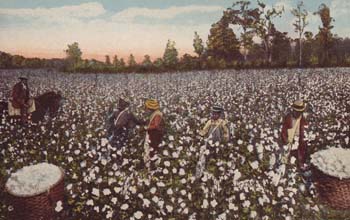
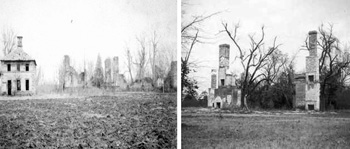 Even the Confederate government considered slavery non-essential to their independence. This is so true that Confederate diplomat Duncan Kenner did not have any problem in offering the abolition of slavery as a bargain to attract the support and diplomatic recognition of the Confederacy from England and France (countries that held anti-slavery positions), though his proposal was not accepted.
Even the Confederate government considered slavery non-essential to their independence. This is so true that Confederate diplomat Duncan Kenner did not have any problem in offering the abolition of slavery as a bargain to attract the support and diplomatic recognition of the Confederacy from England and France (countries that held anti-slavery positions), though his proposal was not accepted.
These are facts that show anyone who is impartial that the South did not fight the war to protect its system of slavery.
Another truth that invalidates this revolutionary saga is that the North actually did not fight to end slavery. In reality, when Lincoln called for volunteers to wage war against the seceding States, there were more slave States in the Union than there were in the Confederacy.
This call for soldiers only confirmed Southern fears that the government had become tyrannical, causing more Southern States to secede in protest of a government that was forcing States to remain members at gunpoint. As part of the official government line, Northern diplomats were instructed to respond to foreign inquiries regarding slavery by stating that this institution would remain unchanged. Even as late as 1861, the exclusively Northern government (the South had seceded) proposed and, then rejected, an amendment to abolish slavery.
To completely shatter this myth of an anti-slavery North, it must be remembered that in the Northern States of Delaware and Maryland as well as the occupied border States of Missouri and Kentucky, slavery enjoyed full protection of the law during the war, with some areas retaining slaves until after the war ended. The federal government protected slavery in these States and even enrolled slave holders from these areas to fight in the Union army against the South.
Even the fabled Emancipation Proclamation only declared slaves to be free in areas that defied the Union, meaning that any slaves in the Northern States or Union-controlled Southern areas remained in bondage. To try and retain white loyalty in areas that were conquered, Lincoln went so far as to cancel liberation orders of Northern abolitionist generals who tried to free slaves in the Southern lands they invaded.
In this way emancipation can be seen as a pragmatic military move by Lincoln, intended to encourage slaves to flee the South, undermining its economy while still retaining the loyalty of Northern slaveholders. Thus, with the Emancipation Proclamation, Lincoln declared free the slaves in States where he had no control and preserved slavery in the lands under his authority, effectively freeing nobody.
The myth of a war of emancipation fought to end slavery, thus, crumbles under historical scrutiny. Any claim to the contrary in our textbooks or media is mere propaganda intended to draw attention away from the unjustifiable, illegal and immoral actions of Lincoln and his government. Such claims defend that usurpation, which bloated the powers of the federal government and established a Union of coercion.
A just appraisal
In this book Miller demonstrates that the Civil War was a war of survival for the Old South against the federal attack. Lincoln usurped State authority, ordered the illegal and unconstitutional invasion of the South, illegally imprisoned thousands of Northerners who opposed him and waged war on false pretenses to secure unlawful power for the federal government. The South legally, morally and philosophically had the right to defend itself from that tyranny. Never again would the States posses the same degree of sovereignty that they had prior to Lincoln.
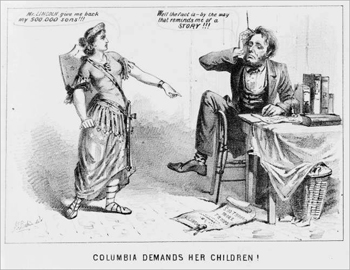 Slavery was but a factor in the war, not the cause. Rather, the cause that brought the Nation to a secession crisis was the increasing overall cultural, political and economic oppression of the South by the North.
Slavery was but a factor in the war, not the cause. Rather, the cause that brought the Nation to a secession crisis was the increasing overall cultural, political and economic oppression of the South by the North.
It was on the false pretense of “preserving the Union” that Lincoln then perpetrated the war, leading the industrialist North to crush the honor-bound and traditional-minded South in a conflict that cost our nation untold destruction and hundreds of thousands of lives. Never again would our Federation be the same.
As an historian, I enjoyed the density of information presented by Miller in this first book of his series. He presents the material in a systematic and straightforward manner without being pedantic. Each topic is addressed from multiple angles, guaranteeing a strong argument from different perspectives. I look forward to reviewing the rest of the series, and I would recommend this book to anyone who wants a Catholic perspective on the causes and justifications for the “War for Southern Independence.”
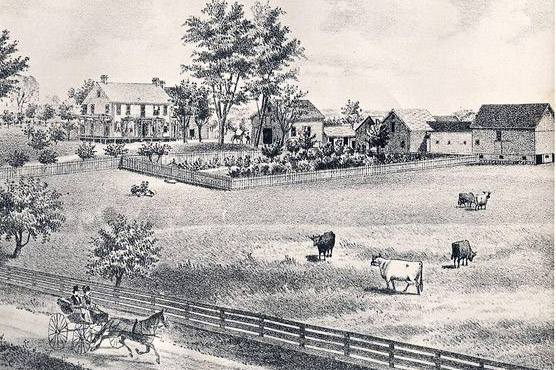 Continued
Continued

Secession
The Republican Party was originally a sectional party predicated on furthering Northern interests, and it was the election of Republican Abraham Lincoln in 1860 that precipitated the secession of several Southern States. Before this time different States, some of them Northern, had threatened to secede over various issues, and there was no doubt as to the legality of such an action. Just that year (1860-1861) Congress had even tried and failed to pass a law that would have officially outlawed state secession.
Many at the time knew that the federal government simply did not have the legal capacity to prevent States from seceding. The Constitution granted no such federal authority. Despite this legal framework, despite the Constitution, and despite the wishes and intentions of the founding fathers (expressed through letters, the Federalist Papers, and the Second amendment and the Bill of Rights) Lincoln retaliated with war.
He called for 75,000 volunteers to put down what he termed the “rebellion” of Southern States. Civil liberties were suspended, and thousands of people who opposed Lincoln’s actions, even loyal Northerners, were imprisoned without trial or due process of law
.

An unconcerned Lincoln with his political machine interested only in 'rolling out the bucks' to the detriment of the South
In order to justify these illegal actions and the federal government's use of force in coercing the Southern States, several myths, misrepresentations and outright lies were constructed. These falsities have been perpetuated and enshrined in our education system and media to this day. Miller refutes each one of these myths by presenting the true historical facts.
First myth: the South was poor and backwards, while the North was rich and sophisticated. This is a lie as we saw in Part I of this series.
Second myth: The war was to preserve the Union. This is, simply speaking, a lie. The seceding States did not threaten the existence of the Union. They did not attempt to conquer the North nor did they demand the dissolution of the United States. They only exercised their right to leave the Union and practice their sovereignty and self governance. They were fighting for independence.
As such the expression ”Civil War” is a misnomer, as the control of the Northern government was never contested. Miller offers a few alternative titles, such as “The War for Southern Independence,” “The War of Federal Aggression” or “The War against Southern Secession” as more accurate options.
Third myth: Secession was treason. This is also a lie. No law prohibited or condemned States for seceding. The power to prevent a State from leaving the Union was not explicitly granted to the federal government and was, thus, retained by the States both by Natural Law and the Constitution.
Even after the war, when Confederate President Jefferson Davis and other Southern leaders were arrested on charges of treason, they were released without trial. The Chief Justice released them without pressing charges because he recognized that any trial would prove they had done nothing illegal, and pressing charges would only serve to strengthen the South's position and undermine the myth that the North was acting legitimately.
Slavery was not the focal point of the war
Fourth myth: The war was fought to free the slaves. This is a blatant lie, although it is the most tenacious and emotionally charged myth. Hardly a student can pass a history course without having it pounded into his head that the South fought to defend the institution of slavery and that the North fought to free slaves in the name of liberty and justice. This particularly sensitive myth deserves special attention.
As discussed, the South went to war primarily in defense of its cultural, political and economic survival. When the vote for secession was made, many pro-secessionist counties had few or no slaves, such as the primarily German Comal County in Texas, while some of the most heavily slave populated areas voted in favor of cooperating with the Union, e.g. the majority of the slave holding families in Southampton in Virginia voted against secession.
Several of the most prominent Southern generals, including Robert E. Lee and J.E.B. Stuart, owned no slaves, nor did the average Southern soldier, who was fighting to protect himself and his home from the pillaging armies and scorched earth tactics of the federal army. Statistically, the majority of Southerners were not slave owners.

Before the Civil War, plantation workers harvesting cotton; after the war, destroyed plantations and no foodstuffs or products

These are facts that show anyone who is impartial that the South did not fight the war to protect its system of slavery.
Another truth that invalidates this revolutionary saga is that the North actually did not fight to end slavery. In reality, when Lincoln called for volunteers to wage war against the seceding States, there were more slave States in the Union than there were in the Confederacy.
This call for soldiers only confirmed Southern fears that the government had become tyrannical, causing more Southern States to secede in protest of a government that was forcing States to remain members at gunpoint. As part of the official government line, Northern diplomats were instructed to respond to foreign inquiries regarding slavery by stating that this institution would remain unchanged. Even as late as 1861, the exclusively Northern government (the South had seceded) proposed and, then rejected, an amendment to abolish slavery.
To completely shatter this myth of an anti-slavery North, it must be remembered that in the Northern States of Delaware and Maryland as well as the occupied border States of Missouri and Kentucky, slavery enjoyed full protection of the law during the war, with some areas retaining slaves until after the war ended. The federal government protected slavery in these States and even enrolled slave holders from these areas to fight in the Union army against the South.
Even the fabled Emancipation Proclamation only declared slaves to be free in areas that defied the Union, meaning that any slaves in the Northern States or Union-controlled Southern areas remained in bondage. To try and retain white loyalty in areas that were conquered, Lincoln went so far as to cancel liberation orders of Northern abolitionist generals who tried to free slaves in the Southern lands they invaded.
In this way emancipation can be seen as a pragmatic military move by Lincoln, intended to encourage slaves to flee the South, undermining its economy while still retaining the loyalty of Northern slaveholders. Thus, with the Emancipation Proclamation, Lincoln declared free the slaves in States where he had no control and preserved slavery in the lands under his authority, effectively freeing nobody.
The myth of a war of emancipation fought to end slavery, thus, crumbles under historical scrutiny. Any claim to the contrary in our textbooks or media is mere propaganda intended to draw attention away from the unjustifiable, illegal and immoral actions of Lincoln and his government. Such claims defend that usurpation, which bloated the powers of the federal government and established a Union of coercion.
A just appraisal
In this book Miller demonstrates that the Civil War was a war of survival for the Old South against the federal attack. Lincoln usurped State authority, ordered the illegal and unconstitutional invasion of the South, illegally imprisoned thousands of Northerners who opposed him and waged war on false pretenses to secure unlawful power for the federal government. The South legally, morally and philosophically had the right to defend itself from that tyranny. Never again would the States posses the same degree of sovereignty that they had prior to Lincoln.

Columbia, a symbol of the country, accuses an indifferent Lincoln of the needless loss of lives
It was on the false pretense of “preserving the Union” that Lincoln then perpetrated the war, leading the industrialist North to crush the honor-bound and traditional-minded South in a conflict that cost our nation untold destruction and hundreds of thousands of lives. Never again would our Federation be the same.
As an historian, I enjoyed the density of information presented by Miller in this first book of his series. He presents the material in a systematic and straightforward manner without being pedantic. Each topic is addressed from multiple angles, guaranteeing a strong argument from different perspectives. I look forward to reviewing the rest of the series, and I would recommend this book to anyone who wants a Catholic perspective on the causes and justifications for the “War for Southern Independence.”

The Saratoga farmstead in Virgina circa 1860;
most Southern landowners before the Civil War were small farmers

Posted March 18, 2016
______________________
______________________
 Volume I |
 Volume II |
 Volume III |
 Volume IV |
 Volume V |
 Volume VI |
 Volume VII |
 Volume VIII |
 Volume IX |
 Volume XI |
 Special Edition |
 Special Edition |
